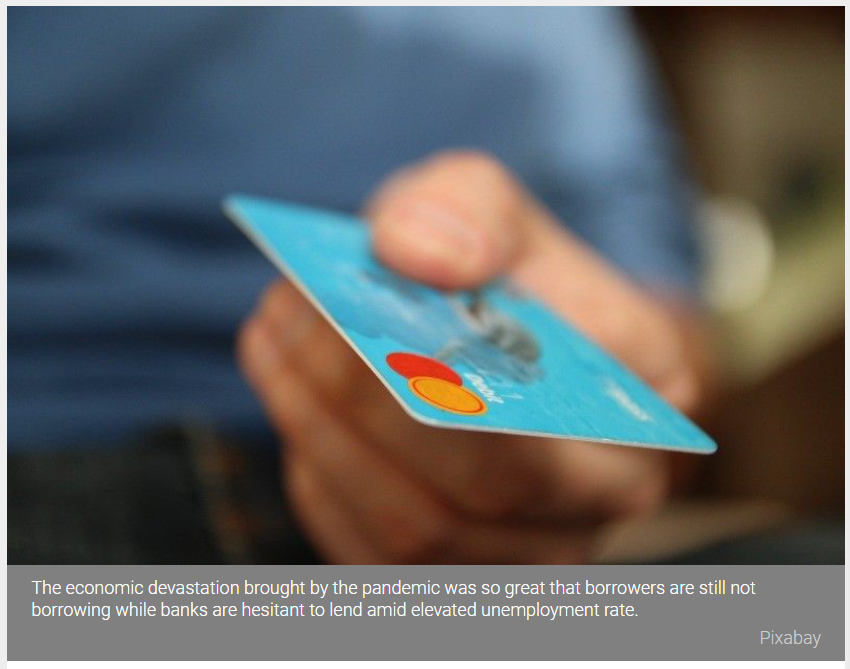Philippines: Banks see their bad debts ‘a little above 5%’ of loans in 2021
MANILA, Philippines — Bad debts are not yet done saddling Philippine banks this year with regulators told to expect them to rise to their highest level since at least 2008, crippling their ability to lend and exacerbating an economic downturn with no end in sight yet.
The local banking industry is seeing non-performing loans (NPL), or debts that remain unpaid at least 30 days past due date, to represent “a little above 5%” of loan portfolio by yearend, Bangko Sentral ng Pilipinas Deputy Governor Chuchi Fonacier said in a text message on Friday.
That means soured loans are yet to reach a peak even as they begin to accumulate this year after state-mandated grace periods that delayed loan payments lapsed. As of end-February, gross NPL accounted for 4.05% of total loans, up from 3.6% in December last year, and the highest since October 2009.
It also meant that lenders are now most likely to dip into their capital to cover potential losses. The so-called NPL coverage ratio, which counts capital set aside for this purpose, is expected to continuously go down from 87.37% in February, the lowest since June 2009. BSP is completing its survey of banks for NPL coverage this weekend.
While already expected, a relentless surge in bad loans presents a roadblock for banks to perform their lending business. Wary of further increase in NPL because joblessness is still elevated and borrowers may not have enough to pay up, banks are saving up their ammunition instead of giving them out as the central bank would have wanted.
BSP, led by Governor Benjamin Diokno, has even held on the record-low benchmark rate at 2% even in the face of rising inflation just to give the economy the liquidity it needs, only for those cash to get stuck in banks and its own credit facilities. On Friday alone, BSP attracted P145.25 billion in tenders for a P90-billion issuance of 28-day securities. The bank awarded as planned.
It goes without saying thought that banks not lending has put a government recovery strategy reliant on loans to shuttered businesses in jeopardy. For Nicholas Antonio Mapa, senior economist at ING Bank in Manila, there is not so much BSP can do now to prod them more.
“BSP noted tighter credit standards implemented by banks given the increased risks associated with lending as of the moment, which has negative impact on already impaired demand from would-be borrowers,” Mapa said in an email.
As a fix, the central bank advocated for the passage of the Financial Institutions Strategic Transfer (FIST) Act, which will establish vehicles where banks can unload their unpaid loans. The law was enacted on February, and while there is little news as to how it is being utilized now, Fonacier said regulators estimate FIST to cut NPL by 0.63 to 0.71 percentage points, helping alleviate the costs of carrying them on balance sheets.
But Mapa is unconvinced FIST is enough to revive lending and borrowing appetites, more so with potential spike in interest rates looming on the background with the most of the global economy on track to recovery, leaving the Philippines behind.
“This would leave domestic rates susceptible to episodes of surging borrowing costs as influenced by a pickup in global rates (likely driven by better growth prospects in select regions),” he said.
Worse, NPL can even end up higher than what is anticipated by banks themselves. Sanjay Mathur, economist at ANZ Research, said the bad loans ratio may fall “somewhere between 5.5-6.5%.” “What we do not know is the credit metrics of borrowers and as to when the economic environment will get better,” he said separately.
“Until then, it is unlikely that credit can resume in full earnest,” he added.
Source: https://www.philstar.com/business/2021/04/23/2093300/banks-see-their-bad-debts-a-little-above-5-loans-2021


 Thailand
Thailand




